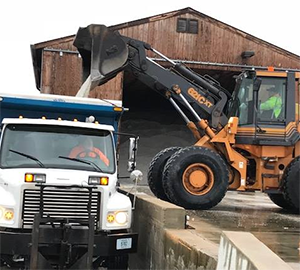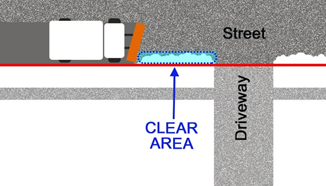Snow & Ice Control
 Maintaining safe winter driving conditions on city streets is a priority of the Seymour Streets Department. Current conditions and weather forecasts are monitored so that crews are ready before the flakes begin to fly.
Maintaining safe winter driving conditions on city streets is a priority of the Seymour Streets Department. Current conditions and weather forecasts are monitored so that crews are ready before the flakes begin to fly.
Snow Removal at a Glance
- Salt is spread when the city determines the streets are in a hazardous condition, with an emphasis on hills, curves, and main intersections.
- Plowing begins when snow accumulations reach one to two inches as measured by the Streets Department.
- The City re-plows or re-spreads based on the available weather information and current street conditions.
- During a typical snowfall, priorities #1 through #3 are cleared within 24 hours after the snowfall ends and are plowed within 24 inches of the curb, unless restricted by parked vehicles.
Priority Order of Plowing Streets
The city plows and treats public streets in the following order (exceptions made for emergencies):
- Arterial streets
- Primary routes
- School zones (typically within a three-block radius around public schools, if in session)
- Remaining residential streets
- Cul-de-sacs/Dead End Roads
Crews are unable to accommodate individual requests to change the priority of street plowing.
Clearing Residential Streets & Cul-De-Sacs
Typical Winter Events
- First, the arterial streets, primary routes, and school area streets (when school is in session) are cleared.
- Then, a plow truck is sent to each section of Seymour to simultaneously remove snow throughout the city.
Severe Winter Storms
During major winter storms:
- Arterial streets, primary routes, and school area streets (when school is in session) are our focus routes during heavy snow fall.
- Then, snowplows are sent to each section of Seymour, as available.
- After the snow stops falling and the arterial streets, primary routes, and school area streets are cleared, plow trucks are sent to each section of Seymour to make an initial pass and simultaneously remove snow throughout the city. All the operators work together to improve efficiency.
- After all zones are cleared, crews begin to push snow back from curbs and haul snow from intersections as needed.
The zone where crews begin is determined by the time of day. Tree coverage and available light are leveraged to maximize efficiency.
Snow at the Bottom of Driveways
Why did the plow leave snow at the bottom of my driveway?
As the plow moves down the street, the snow rolls off the edge of the blade and into the gutter line. You can always expect that there will be snow at the bottom of driveways after the street is plowed, so plan ahead. It is not possible to efficiently plow the street and keep driveway aprons free of snow.
What you can do about it
You can reduce the amount of snow the plow leaves in your driveway if you are able to clear a path tight to the curb in the area before the plow reaches your driveway:
- If you can safely do so, clear a pocket of snow from the left side of your driveway as you face the road.
- The accumulated snow on the plow will dump into the pocket, and less in your driveway.
By the Numbers
- Total Lane Miles - 108
- Cul-de-sacs - 80+
- Snow team employees - 14
- Single axle trucks - 6
- Tandem truck - 1
- Anti-ice units to pre-treat roads - 6

